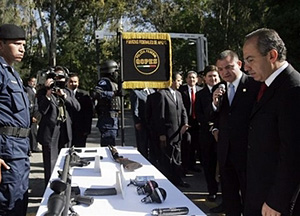 |
 |
 |
 News Around the Republic of Mexico | March 2007 News Around the Republic of Mexico | March 2007  
Calderón Announces Anti-Crime Plan in Wake of Police Chief's Shooting
 Mark Stevenson - Associated Press Mark Stevenson - Associated Press


| | In this photo released by the Office of the Mexican Presidency, Mexico's President Felipe Calderon, right, inspects new weapons and law enforcement tools accompanied by the Mexican Public Safety Secretary, Genaro Garcia Luna, second from right, during an event where Calderon announced a new, high-tech anti-crime network in Mexico City, Wednesday, March 7, 2007. (AP/Office of the Mexican Presidency/Alfredo Guerrero) |
Mexico City – President Felipe Calderón pledged “a hard and difficult battle” against gangs Wednesday, a day after gunmen wounded the top security official in the Gulf coast state of Tabasco and killed his driver.

Calderón, who has made fighting Mexico's powerful gangs and drug cartels a focus of his presidency, announced a high-tech, anti-crime network and inspected ranks of new patrol cars, drug-sniffing dogs and police equipment.

“We know that the fight against crime is a hard and difficult battle, that is already having significant costs, will take time, and unfortunately will continue taking human lives,” Calderón said. “The public is fed up with the lack of public safety, and my government is determined, absolutely determined, to battle and defeat it.”

Calderón presented a plan he called “Platform Mexico” to help federal, state and local police exchange information and build an intelligence data base on drug gangs. It involves a computer network for voice and data transmission that will link 200 police stations initially. It will be expanded to include 5,000 stations by 2009.

Mexican officials have been promising improved systems to share information on crimes nationwide for more than a decade.

The plan also includes a project to recruit college graduates to work in the federal police forces – many current officers have barely finished high school – and programs to combat drug addiction.

On Wednesday, police were searching vehicles at checkpoints surrounding Villahermosa, the Tabasco state capital, as they hunted for the gunmen who wounded retired Gen. Francisco Fernandez and killed his driver.

Tuesday's attack, in which Fernandez's vehicle was riddled with more than 100 bullets, was the most brazen assault on a senior security official since Calderón launched a crackdown against drug trafficking after taking office in December.

Fernandez, who was shot in the shoulder, was listed in stable condition.

Drug traffickers appeared to be behind the attack, said Cesar Romero Valenzuela, the local representative of Mexico's federal attorney general's office. He added that police had made one arrest and were searching for more suspects.

Calderón has sent more than 24,000 soldiers and federal police to areas ravaged by drug violence, including Acapulco, Tijuana and the western state of Michoacan. Calderón has also extradited four cartel kingpins to the United States.

While his administration says it does not fear Colombian-style reprisals from drug gangs, there have been several attacks on law enforcement officials here since December.

On Feb. 19, assailants with assault rifles attacked a vehicle carrying federal Congressman Horacio Garza in the border city of Nuevo Laredo, wounding him and killing his driver.

On Feb. 6, more than a dozen armed assailants staged simultaneous attacks against two police stations in the resort city of Acapulco, killing five officers and two secretaries.

Calderón has tried to combat the image that Mexico's law enforcement efforts have been outstripped by the drug cartels, who are fighting for control of profitable smuggling routes to the U.S. market.

On Wednesday, Calderón inspected some of the federal police force's latest gear, patting the heads of drug-sniffing dogs, trying out new patrol cars equipped with video cameras, and climbing aboard a mobile gamma-ray inspection unit used to check vehicles for contraband.

“This is a battle we are going to win,” Calderón said. | 
 | |
 |



